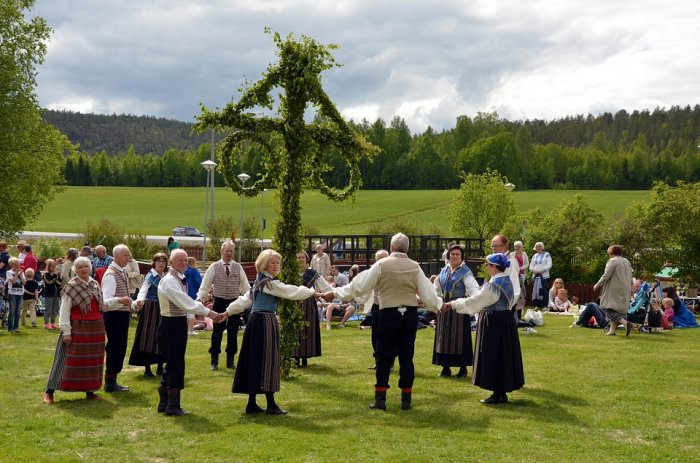Ellen Lloyd - AncientPages.com - Every year on June 21, a global community comes together to celebrate the summer solstice. These vibrant and enchanting festivals, deeply rooted in ancient traditions, continue to thrive in our modern world.
Midsummer in Sweden. Credit: Adobe Stock- Birgitta
While the foods, drinks, clothes, and dances may vary, one thing remains constant-the universal appreciation for the summer solstice, the longest day of the year. This celestial event, when the Earth’s poles are at their maximum tilt towards the Sun, is a time of joy and celebration across cultures.
Midsummer In Sweden
In countries like Sweden, the Midsummer (‘Midsommar’ in Swedish) celebration is a joyous event, almost as significant as Christmas.
The traditional Midsummer celebration, set in the picturesque countryside, is a sight to behold. One of the most spectacular summer solstice festivals takes place at the Skansen open-air museum in Stockholm.
On Midsummer Eve, the air is filled with the sounds of traditional songs and the sight of people in colorful costumes dancing around a midsummer pole.
Traditional Midsummer celebration in Sweden. Credit: Public Domain
This is a fertility rite, and the pole is decorated with greenery and flowers. Traditional foods such as pickled herring and potatoes with soured cream and chives are consumed, washed down with Schnapps and spiced vodka.
Ukon Juhla – Midsummer Festival In Finland
In Finland, the Ukon Juhla festival, also known as 'Ukko's Celebration,' stands as a testament to the country's rich cultural heritage. Originally dedicated to Ukko, a prominent figure in Finnish mythology, god of thunder, sky, and harvest, the festival is a testament to the country's rich cultural heritage.
The festival has evolved over time and now bears the name 'Juhannus' in honor of John the Baptist, a symbol of the country's Christian heritage. This rebranding is a fascinating example of how cultures evolve and adapt over time.
During the Ukon Juhla festival, residents experience prolonged periods of darkness for approximately half the year- A key tradition involves lighting large bonfires, symbolizing the triumph of light over darkness, marking the arrival of summer, and historically, believed to ensure good harvests and ward off evil spirits.
Calm midsummer night in Turku archipelago, Finland. Image credit: Adobe Stock - nulikka
The festival typically occurs around the summer solstice, coinciding with the time when Finland experiences nearly constant daylight, providing a stark contrast to the long, dark winter months.
Summer Solstice Celebration In UK
In the United Kingdom, it’s customary for Druids to gather around Stonehenge to celebrate the summer solstice.
Summer Solstice Sunrise over Stonehenge. Credit: Andrew Dunn - CC BY-SA 2.0
Usually, thousands of people come to celebrate the first day of the summer. Glastonbury Tor in Somerset and the Avebury stone circle in Wiltshire also attract crowds.
The atmosphere is truly magical, and celebrating the summer solstice in the United Kingdom is an unforgettable experience.
Also called Litha by Pagans, the Summer Solstice Sabbat honors the only day the rising Sun reaches the middle of the stones. When this happens, the Sun shines on the formation’s central altar, and it’s a great moment, especially for more spiritual people.
Summer Solstice Festival In Spain
Spain is a deeply religious country. Although most of the population is Catholic, some ancient traditions dating back to Pagan times are still appreciated despite the Christian elements.
For example, the summer Solstice is celebrated in Spain on June 23. During the feast day of St John, known as San Juan in Spain, it’s customary to light huge bonfires, dance, drink, and eat.
The summer solstice traditions in Spain vary between regions. For example, in Lleida, one of the cities in the west of Catalonia, residents celebrate the summer solstice by zigzagging from the mountaintop to the town square carrying burning branches. After a huge bonfire, townsfolk dance until dawn.
The International Day Of Yoga In The USA
It may sound a bit surprising, but the International Day of Yoga on June 21 is also the summer solstice in the United States.
The UN inaugurated the festival in 2015, and it is popular. Thousands of people practicing yoga travel to New York and other cities yearly on this day. There, they gather at Times Square to mark the occasion by participating in a free class held in the city’s iconic heart.
Kupala Night – Slavic Celebration Of Summer Solstice
People in Poland (‘Noc Kupały’ in Polish), Russia, and Ukraine celebrate a festival known as Kupala Night.
On Kupala Night crowns are placed on water. Divination on the Wreaths - Credit: Simon Kozhin, CC BY-SA 3.0
This summer solstice celebration involves joyful outdoor celebrations with bonfires, dancing, and singing. It’s customary for young women to make beautiful crowns from herbs and wildflowers.
The jump over fire ritual for Lada, the goddess of beauty, love, harmony, and order, is still practiced.
In Russia and Ukraine, this holiday combines "Ivan" (John, in this case, John the Baptist). In Poland, the holiday was incorporated into the Christian calendar as St. John’s Eve. As a result, the conventional Polish celebrations of midsummer are an interesting mix of pagan and Christian influences.
Summer Solstice In Mongolia
Under Communist rule, shamanism was banned in Mongolia for 70 years. However, in 1992, the country’s constitution protected ancient traditions.
The distance between Mongolia and European countries is vast, but the traditions are similar. For example, celebrating the summer solstice in Mongolia involves several fire rituals.
There are many other countries where the summer solstice is celebrated yearly. Each culture has its unique ancient tradition.
First version of this article was published on June 20, 2021
Written by Ellen Lloyd – AncientPages.com
Copyright © AncientPages.com All rights reserved. This material may not be published, broadcast, rewritten or redistributed in whole or part without the express written permission of AncientPages.com







